
A slew of high-rise commercial and residential development proposals are expected to flood the Parramatta central business district after the NSW government signed off on the long-awaited planning proposal.
The 40-year vision by the Parramatta City Council, which has been in development for almost a decade, will allow for towers of up to 69 storeys for mixed-use residential buildings and 52 storeys for commercial towers with a 10:1 floor-space ratio.
The heights are less than the council’s original proposal for residential towers of 75 storeys and commercial buildings of 60 storeys.
The revised planning controls will also expand the boundaries of the CBD.
As well, the plan will introduce new flood mitigation rules for properties near the river and require commercial premises to have end-of-trip facilities to encourage cycling.
Its endorsement is now expected to fast-track the delivery of more than 1.5-million square metres of new commercial floor space, providing for an estimated 43,000 new jobs, as well as 12,000 new dwellings during the next 40 years.
Associated work along Parramatta Road is also expected to create a further 27,000 new homes and 50,000 jobs during the next 20 years.
Absent from the control changes was Parramatta North and the Phillip Street Block, with decisions postponed due to concerns over their heritage and public amenity values.
NSW planning minister Anthony Roberts said the time was right to optimise land for homes while building sustainable and resilient communities in western Sydney.
“Work is already under way to bring to life our vision for the road and surrounds,” Roberts said.
“The completion of this analysis enables councils to progress planning proposals to unlock hundreds of millions—if not billions—of dollars worth of investment.”

Business Western Sydney executive director David Borger said the decision ensured that Parramatta could continue its transformation into a modern metropolis.
“Parramatta has outgrown its clothes, it’s bursting at the seams [and] it’s time to think about extending the CBD boundaries,” Borger said.
“It is good to have certainty after nine years of debate but the government also needs to set planning controls for north Parramatta urgently, with the light rail due to open next year.”
As well as the delivery of the Parramatta Light Rail, due for completion in 2023, construction of a new Sydney Metro West station is also advancing with track construction expected to be complete later this year ahead of passenger services starting in 2024.
PCA regional director of western Sydney Ross Grove said demand across all asset classes in Parramatta continued to outstrip supply by 15,000 square metres.
“Put simply, we have more people coming in and out,” Grove said.
“The fundamentals of Parramatta are incredibly strong. A shared public and private vision for the future of the city has been supported by an ambitious infrastructure program.
“Parramatta’s office market will perform well as the city continues to become an employment destination of choice for the surrounding population catchment.”

Central to Parramatta’s transformation has been Parramatta Square, a $2.8-billion project with four towers, which Walker Corporation broke ground on in 2017.
Harry Triguboff’s Meriton also has ambitious plans for Sydney’s second CBD with work advancing on a two-tower development, 180 George, which will comprise 800 apartments.
Parramatta lord mayor Donna Davis said attention would now be turned to the state government’s finalising of the council’s CBD Contributions Plan which, if approved, would replace an earlier iteration from 2007.
“In order for the transformation of our city to be truly successful, we call on the state government to endorse our supporting CBD Infrastructure Contributions Plan as soon as possible,” Davis said.
“This will ensure developers pay their fair share, so we have the necessary funding to deliver the infrastructure, facilities and services needed for our growing community.”
The council’s draft plan, endorsed in mid-2021, called for the council to be able to receive approximately $1 billion in income from development over 40 years with the increased percentage rates proposed.
The council has previously estimated a funding gap of up to $430 million in community infrastructure funding could emerge over the next four decades if its contributions plan is not endorsed.
Under the plan, an estimated $640 million could be collected from developers over that period to pay for community infrastructure in the CBD, compared to just $200 million under the state government’s proposed rates.
Davis said developers have long been aware of the plan and the market had already priced in the new rates.
The council has been collecting contributions equivalent to the rates outlined in its own CBD contributions plan since 2017.
In addition, the state government has also flagged potential future changes to section 7.11 contributions—charged when there is a demonstrated link between a development and the infrastructure to be funded.
If pursued, this could reduce money collected from developments outside the CBD by an estimated $200 million, limiting what kind of infrastructure can be delivered in suburban areas.